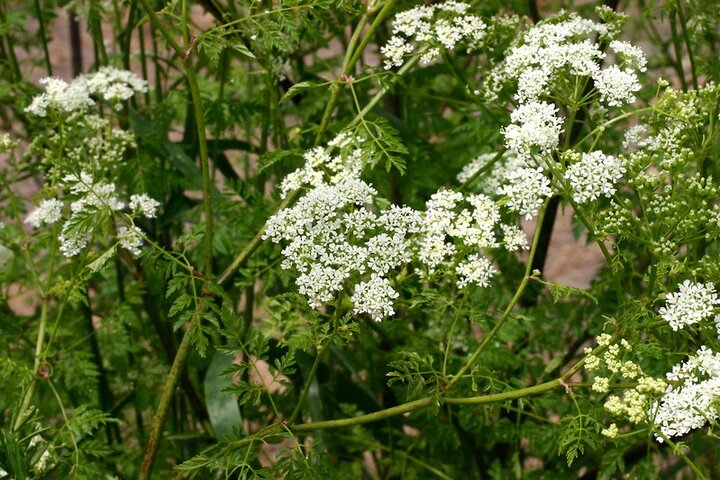Water Hemlock
Tall, white flowers in your hay meadow may be pretty to look at, but beware — they could be water hemlock, one of the most toxic plants to livestock in Nebraska.
Unlike its toxic cousin poison hemlock, spotted water hemlock — or simply water hemlock — is a perennial plant found in wet areas. Identifying it is crucial. Look for a hollow, purplish-streaked stem, small white umbrella-shaped flowers from July to September and leaves resembling parsley or celery.


Water hemlock poses a significant risk to all classes of livestock. Cattle can be poisoned by consuming just 10 ounces of plant material, especially in spring when the new leaves are most toxic. Luckily, animals often avoid grazing on it, so poisoning cases are rare.
The real danger arises if water hemlock gets into your hay. Animals may accidentally consume it, especially if the bale is ground before feeding. Avoid haying areas where water hemlock is present.
Herbicides can be used to successfully control water hemlock but are most effective on new growth. Avoid spraying plants in areas where animals are or may be grazing soon, as herbicide treatment may make the plant more appealing for grazing. Preventing seed spread this year can reduce population growth and because the plant likes wet soils, improving drainage may help with control as well.
Water hemlock may look harmless with its tall white flowers, but it poses a serious threat to your livestock. Identify, control and prevent its spread to keep your animals safe.
Adding Grass to Thinning Alfalfa
Do you have a thinning and low producing alfalfa stand but are not quite ready to do a complete reseeding? These stands can be rejuvenated by interseeding grasses to increase hay production in subsequent years or to convert them to pasture.
Most alfalfa fields start to lose stand and production potential after cutting hay for several years. Orchardgrass is the grass most commonly interseeded into alfalfa, but other grasses like endophyte-free tall fescue, smooth or meadow brome, festulolium and wheatgrasses also can be used. If the field will be used as pasture, a mixture of several grasses may be best since it adds diversity to your animals' diet.
Whether irrigated or dryland, interseeding after a mid-August to early September hay harvest can be excellent timing. There is always some risk for dryland fields because several rains will be needed to start the new grass seedlings. The seeding should be done as sone as that August or early September harvest is complete. If your alfalfa is relatively thick, you probably will need to take another cutting in about four weeks, or as soon as the alfalfa starts to form a full canopy. This allows sunlight to continue to reach new grass seedlings below the alfalfa.
The seeding rate of the grasses will vary depending on the species that is used and how thick the existing alfalfa is. With orchardgrass for example, as little as 3 lb/acre might be adequate in a relatively thick alfalfa stand or up to 6 lb/acre in a very thin alfalfa stand.
Next spring, you will need to judge how well established the new grasses have become. If they seem a little weak, cut hay early to open the canopy for better light penetration.
Storing to Reduce Hay Losses
Summer hay harvest is in full swing. As you bring in your round bales for winter feeding, are you storing them in a way to minimize weather losses?
Hay stored outside will be damaged by rain, snow, wind and ice this fall and winter. The average round bale may lose up to one-fourth of its original nutrients during storage, but these losses can be reduced to less than 10% or so.
If we can’t get bales inside or under a tarp, giving space for air to flow around the bale to dry them out when moisture does fall is better than placing them side to side where rain, snow and ice will gather and get trapped. Stacking uncovered will create a similar problem. Worst of all is placing round bales on their ends so moisture is able directly enter the bale.
Does snow drift around your bales? Bales placed in east-west rows often have drifts on the south side. Hay next to fencelines or trees can get extra snow. As snow melts, it soaks into bales or makes the ground muddy. Plus, the north side never gets any sun so it's slow to dry. This year, line your bales up north-and-south for fewer drifts and faster drying as sunlight and prevailing winds hit both sides of the row.
Most important is the bottom of your bales. Always put bales on higher, well-drained ground so water drains away from them. If necessary, use crushed rock, railroad ties or even pallets to elevate bales to keep the bottoms dry. This also will reduce problems getting to your hay due to snow drifts or mud.
Plan now to store bales outside right. Use a single row of bales end to end, along with consideration for row orientation, and ground surface drainage for the best outcome.
